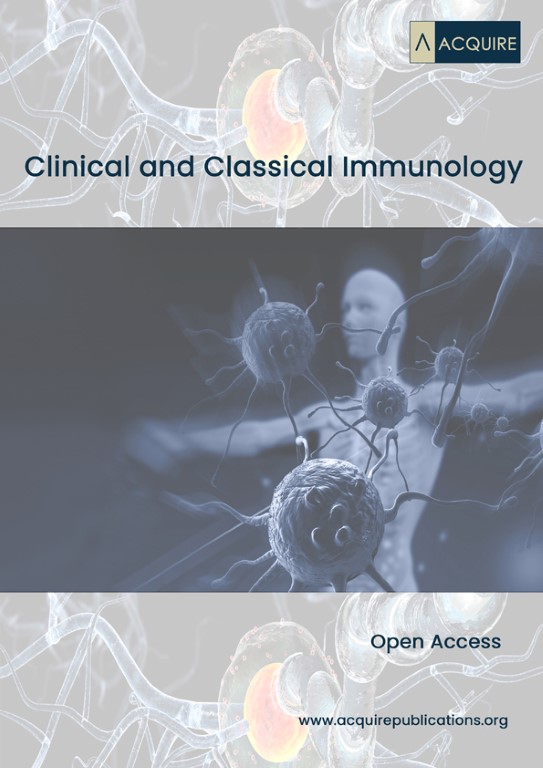>Corresponding Author : Michel Leclerc
>Article Type : Brief Report Article
>Volume : 1 | Issue : 1
>Received Date : 27 August, 2021
>Accepted Date : 9 September, 2021
>Published Date : 12 September, 2021
>DOI : https://doi.org/10.54289/JCCI2100102
>Citation : Leclerc M (2021) Entiere Identities Between Ophiocomina Nigra Igkappa Gene and Human Immunoglobulin Kappa Locus. New Aspects of Invertebrate Igkappa Genes (Ipa). J Clin Class Immunol 1(1). doi https://doi.org/10.54289/JCCI2100102
>Copyright : 2021 Leclerc M. This is an open-access article distributed under the terms of the Creative Commons Attribution License, which permits unrestricted use, distribution, and reproduction in any medium, provided the original author and source are credited.
Brief Report Article | Open Access
Immunology of Invertebrates, Biology/Biochemistry, Orleans University, France
*Corresponding author: Michel Leclerc, Immunology of Invertebrates, Biology/Biochemistry, Orleans University, France
Abstract
Entire identities between Invertebrate Ophiocomina nigra IGKappa gene and Human IGK gene are confirmed, in the present work, at the level of immunoglobulin domains (constant and variable).
Keywords: IGKappa; Ophiocomina
Abbreviations: DNA: Deoxyribonucleic acid, RNA: Ribonucleic acid.
Introduction
The transcriptome of the Ophuirid: Ophiocomina nigra IGKappa gene was discovered recently [1]. Since it was synthesized de novo and cloned in a pUC-GW-Kan plasmid [2] which was a gift of Bo Huang laboratories. The original sequence of the IGKappa gene, after cloning, was the following in 5’-3’:
Original sequence:
GAGGAACTGCTCAGTTAGGACCCAGACGGAACCATGGAAGCCCCAGCGCAGCTTCTCTTCCTCCTGCTACTCTGGCTCCCAGATACCACTGGAGAAATAGTGATGACGCAGTCTCCAGCCACCCTGTCTGTGTCTCCAGGGGAAAGAGCCACCCTCTCCTGCAGGGCCAGTCAGAGTGTTACCAGCAACTTAGCCTGGTACCAGCAGACACCTGGGCAGTCTCCCAGGCTCGTCATCTATGGTGCATCCAGCAGGGCCAGTGGTGTCCCAGCCAGGTTCAGTGGCAGTGGGTCTGGGACAGAGTTCACTCTCACCATCAGCAGCCTGCAGTCTGAAGATTTTGCAGTTTATTACTGTCAGCAGTATAATAAGTGGCCGCACACTTTTGGCCAGGGGACCAAGCTGGACATCAAACGAACTGTGGCTGCACCATCTGTCTTCATCTTCCCGCCATCTGATGAGCAGTTGAAATCTGGAACTGCCTCTGTTGTGTGCCTGCTGAATAACTTCTATCCCAGGGAGGCCAAAGTACAGTGGAAGGTGGATAACGCCCTCCAATCGGGTAACTCCCAGGAGAGTGTCACAGAGCAGGACAGCAAGGACAGCACCTACAGCCTCAGCAGCACCCTGACGCTGAGCAAAGCAGACTACGAGAAACACAAAGTCTACGCCTGCGAAGTCACCCATCAGGGCCTGAGCTCGCCCGTCACAAAGAGCTTCAACAGGGGAGAGTGTTAGAGGGAGAAGTGCCCCCACCTGCTCCTCAGTTCCAGCCTGACCCCCTCCCATCCTTTGGCCTCTGACCCTTTTTCCACAGGGGACCTACCCCTATTGCGGTCCTCCAGCTCATCTTTCACCTCACCCCCCTCCTCCTCCTTGGCTTTAATTATGCTAATGTTGGAGGAGAATGAATAAATAAAGTGAATCTTTGCAAAAAAAAAAAAAAAAAAAAAAAAAAAAAAAAAAAAAAAAAAAAAAAAAAAAAAAAAAAAAAAAAAAAAAAAAAAAAAAAAAAAAAA
The original gene, the original protein issued from this last one share total identity with Homo sapiens immunoglobulin kappa locus, mRNA (cDNA clone MGC:22645 IMAGE:4700961): they have a complete identity (Figure1).
The Sequence of the concerned gene is ID: BC030813.1
At last, the Protein GenBank [3] has the following number: AAH30813.1 with 234 amino acids as shown below:
MEAPAQLLFLLLLWLPDTTGEIVMTQSPATLSVSPGERATLSCRASQSVTSNLAWYQQTPGQSPRLVIYGASSRASGVPARFSGSGSGTE
FTLTISSLQSEDFAVYYCQQYNKWPHTFGQGTKLDIKRTVAAPSVFIFPPSDEQLKSGTASVVCLLNNFYPREAKVQW
KVDNALQSGNSQESVTEQDSKDSTYSLSSTLTLSKADYEKHKVYACEVTHQGLSSPVTKSFNRGEC
It is shown, for the first time, that an invertebrate IGKappa gene shares entiere identity with a human immunoglobulin (Fig.1)
Figure 1: IGK@ protein [Homo sapiens] graphic (in dark) by NCBI shares IG domains with Ophiocomina nigra IGKappa protein (in grey) issued from ophuirid IGKappa gene.
GenBank: AAH30813.1 protein issued from IGK gene has two immunoglobulin domains:
1. Region 1
Region: IgV_L_kappa
Comment: Immunoglobulin (Ig) light chain, kappa type, Variable (V) domain
Location: 22…126
Length 105 aa
2. Region 2
Region: IgC_L
Comment: Immunoglobulin constant domain
Location: 132…231
Length 100 aa
References
- Leclerc M, Marie Y, Davoult D, Jolly A, de la Grange P (2018) A true new gene in ophiocomina nigra: an ophuirid Igkappa gene. Appl Biotechnol Bioeng. 5(1): 17-18. [Ref.]
- Leclerc M (2021) Submission Imlet. Immunol Lett. [Ref.]
- Hutchinson AT, Jones DR, Winter PM, Tangye SG, Raison RL (2014) Cell membrane associated free kappa light chains are found on a subset of tonsil and in vitro-derived plasmablasts. Hum Immunol 75(9): 986-990. [PubMed.]
